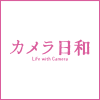[Part 3] Ways to Shoot Photos with Sparkling and Bokeh Impression
Here in [Part 3] of this series article, find out how to use the camera functions to be more creative! Let's dive further into the know-hows on "capturing that ‘child-like' moment," "producing pictures with impact," "composition," "brightness," and "bokeh" for complete beginners and entry-level users of digital SLR. With the use of photos, professional photographer, Yuji Ogura will give tips on how to take cute pictures. (Written & Organized by: Camera Biyori Editorial Department)

I placed the focus on the pear and daringly blurred the mischievous expression.
Bokeh Makes the Subject More Adorable!
Increasing the size of the bokeh creates a gentle and adorable impression. It also has the effect of emphasizing the subject in focus. While it is a basic rule to focus on the eyes when taking portrait shots, you can also set the focus elsewhere if there are other areas you wish to highlight.

This shot was taken with the focus set on the shirt buttons. Recording objects such as the clothes worn helps to bring more pleasure when you look back on the photos.
Useful Tips!

Camera Setting: Aperture-priority AE mode
In the "Aperture-priority AE mode," the photographer chooses the "aperture (f-number)," which determines the size of the bokeh, while the camera automatically sets the shutter speed. Select the "Av" mode from the menu display or Mode Dial.
Photo-taking Tip
Photographing with open aperture!
Set the lens “aperture (f-number)” to the lowest value. The smaller the f-number, the narrower the depth of field becomes, and the size of the bokeh in the foreground and background increases. The aperture value is expressed with an "f" in front, such as “f/2.8.”
A Bright Picture Creates a Sparkling Impression

Suppressing the brightness and retaining the details of the curtain, it is a piece that conveys the atmosphere of the environment.
When capturing portrait subjects, a bright backlit photo helps to create a lively impression. The laced curtain at the window side provides a simple backdrop to bring out the subject. This is recommended for taking commemorative family photos, for example.

Taken in front of a laced curtain at the window side with increased exposure compensation. The finishing is a refreshingly bright impression.
Useful Tips!

Camera Setting 1: Program AE Mode
In the "Program AE mode," the “aperture (f-number)” and “shutter speed” setting combination automatically determined by the camera can be adjusted by the photographer. Photos with the desired level of brightness can also be easily produced using the exposure compensation function. Choose the "P" mode from the menu display or Mode Dial.

Camera Setting 2: Increasing the exposure compensation
"Exposure" determines the brightness of a photo, and by increasing or decreasing the amount of exposure compensation, the brightness of a photo can be adjusted. The degree of compensation could be set to different levels.

Without exposure compensation

Exposure compensation increased
Photo-taking Tip
Photographing against backlight!
The direction of light can be divided into "direct light," "side light," and "backlight." In backlit conditions, the light source (such as the sun) is behind the subject. When a shot is taken in this condition, the subject would turn out dark. However, by increasing the brightness using the exposure compensation function, the image would appear gentle with the subject enveloped in the light.
Camera and Lenses Used

EOS 100D & EF-S18-55mm f/3.5-5.6 IS STM (35mm format equivalent: approx. 29-88mm)
The latest model in the EOS three-digit series, which is popular for shared use among family members. The ultra-compact body that fits comfortably in the hand is amazingly light, weighing about 370g. Perfectly suited for taking child photos, it is a model that you cannot part with even for a moment.
* This article is created based on a trial model. Aspects such as the appearance and image quality may differ slightly from the actual product.

Ogura's work in photography expands from shooting photographic works to development and printing films. He is one of the tutors at the "Camera Biyori Photography School". He started his career as an engineer at a film laboratory and later establishes his own "mogu camera" lab. He also runs the "mogu sun" portrait studio.

Camera Biyori is a Japanese photography magazine introducing charming photos and daily joy with cameras. Suggesting fun activities relating to cameras and photography, Camera Biyori editorial department also offer the "Camera Biyori Photography School" to recommend its readers to engage in photography and have fun.
Published by Daiichi Progress Inc.
































